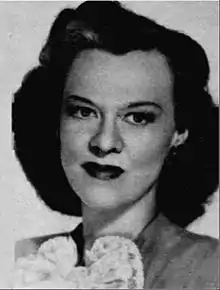Irene Beasley
Elizabeth Irene Beasley (January 28, 1904 – January 7, 1980),[1] known as the "long, tall gal from Dixie,"[2] was a singer and master of ceremonies best known for her work on old-time radio.
Irene Beasley | |
|---|---|
 Beasley in 1949 | |
| Born | Elizabeth Irene Beasley January 28, 1904 Whitehaven, Tennessee |
| Died | January 7, 1980 (aged 75) Ardsley, New York |
| Nationality | American |
| Occupation | Singer |
Early years
Born Elizabeth Irene Beasley,[3] before she was 2 years old, she was singing several children's songs. When she was 3 years old, she sang for a Sunday School Children's Day program. At 4, she played piano by ear.[4]
Beasley's family moved to Amarillo, Texas, when she was 6 years old, and she attended primary and secondary schools there. She went to Sweet Briar College, in Virginia.[5]
Beasley taught music and mathematics[4] in a school in Lamont, Mississippi.[6] During time off from teaching, "she sold records in a phonograph shop and sang the latest songs in a five-and-ten."[1]
Radio
Beasley "pioneered the idea of singing commercials, and handled many for Procter & Gamble."[1]
Sources differ on when Beasley began appearing on radio. One says that she began singing with Francis Craig's orchestra on WSM in Nashville in 1925.[7] Another says that her debut in radio came in 1928 in Memphis, Tennessee,[1] when she sang her own composition.[8] The New Orleans Times-Picyaune on Oct 7, 1928, p 29 quotes her as saying in 1924 she approached radio artist Art Gillham, "The Whispering Pianist" asking him to sing her newly published song "If I Could Just Stop Dreaming." He told her "If you can carry a tune at all, you can do your own advertising and it will be an asset to the song. Just make 'em like it." She said that gave her the courage to sing on radio.In 1924 she sang it on WMC in Memphis, then Chicago stations. She became billed as a blues singer "the long tall gal from Dixie." She made records for Victor. By 1931 she had become "staff artist" at KMOX in St. Louis, Missouri.[9]
In the early 1930s, she "costarred with Ted Husing every Thursday over CBS."[10] She also had her own 15-minute program three nights a week on CBS.[11] On July 15, 1934, she launched her own program on NBC.[12] In 1935, she sang on the Monday and Friday editions of a program headlined by organist Jesse Crawford.[13]
In 1938, she developed R.F.D. #1,[1] a CBS program that Radio Guide described as "a 'one man' show of music and homely commentary dedicated largely to America's farm women." [14] Beasley was the writer, director, and sole actor for the program, which debuted July 4, 1938.[15]
In the early 1940s, Beasley starred in Neighbors, a daytime program on the "Dixie Loop of CBS."[16] She was also the writer, producer, and host of Grand Slam, a musical quiz program that was broadcast 1943-1953.[17]
A national magazine named Beasley "Queen Of Radio" in 1934.[18]
Stage and nightclubs
Beasley "performed for a year in Chicago theaters, studios, and clubs."[3] Later, she "performed in nightclubs and vaudeville houses throughout the country and starred in the musical comedy Thumbs Up."[3]
Composing
When she was a teacher, Beasley wrote her first song and convinced her father to have it published. During a vacation, she was a pianist for a radio station in Memphis when station officials persuaded her to sing on the air. That resulted in her performing her composition and being paid for it. As time went on, she wrote other songs and eventually signed with Victor Records, singing her own compositions.[4]
Later years
In the 1950s, Beasley retired from radio and devoted her efforts to real estate.[1]
References
- DeLong, Thomas A. (1996). Radio Stars: An Illustrated Biographical Dictionary of 953 Performers, 1920 through 1960. McFarland & Company, Inc. ISBN 978-0-7864-2834-2. P. 26
- Dunning, John. (1998). On the Air: The Encyclopedia of Old-Time Radio. Oxford University Press. ISBN 978-0-19-507678-3. P. 348.
- "Irene Beasley Papers". University of Maryland Libraries. Retrieved 19 March 2016.
- Hagy, Lewis Y. (April 11, 1933). "Success Is a Habit With Irene Beasley" (PDF). Radio Guide. pp. 2, 17. Retrieved 16 March 2016.
- Gurman, Joseph; Slager, Myron (1932). Radio Round-ups: Intimate Glimpses of the Radio Stars (PDF). Lothrop, Lee & Shepard Co. p. 82. Retrieved 16 March 2016.
- Siegel, Norman (July 30, 1938). "Irene Beasley Happy in Farm Gal Role On Radio; Never Did Like Being 'Citified'". Ottawa Citizen. Retrieved 19 March 2016.
- Wynne, Joseph (September 1938). "Home Town Boy Makes Good Music" (PDF). Rural Radio. p. 11. Retrieved 17 March 2016.
- "(untitled brief)" (PDF). Broadcast Weekly. August 2, 1931. p. 11. Retrieved 16 March 2016.
- "Irene Beasley Got Her Radio Start On Station KMOX". St. Louis Media History Foundation. Retrieved 19 March 2016.Originally published in Radio and Entertainment November 21, 1931.
- "Studio Gossip" (PDF). Radio Guide. February 28, 1932. p. 6. Retrieved 16 March 2016.
- "News of the Studios" (PDF). Radio World. June 25, 1932. p. 19. Retrieved 17 March 2016.
- "Inside Pickups" (PDF). Radio Guide. June 9, 1934. p. 30. Retrieved 17 March 2016.
- Kaufman, Samuel (March 1935). "Backstage in Broadcasting" (PDF). Radio News. Retrieved 19 March 2016.
- "(photo caption)" (PDF). Radio Guide. August 13, 1938. p. 17. Retrieved 16 March 2016.
- "Farmer Girl" (PDF). Radio Guide. July 9, 1938. p. 2. Retrieved 16 March 2016.
- Johnson, Ted (October 16, 1943). "Neighbors" (PDF). p. 11. Retrieved 17 March 2016.
- "Irene Beasley". Taking a Leading Role. Retrieved 19 March 2016.
- "Deaths" (PDF). Billboard. March 8, 1980. p. 64. Retrieved 17 March 2016.